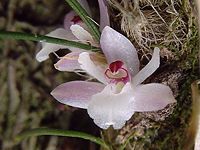Isabelia
| Leptotes | ||||||||||||||||||||
|---|---|---|---|---|---|---|---|---|---|---|---|---|---|---|---|---|---|---|---|---|
 Isabelia virginalis
| ||||||||||||||||||||
| Scientific classification | ||||||||||||||||||||
| ||||||||||||||||||||
| Type species | ||||||||||||||||||||
| Isabelia virginalis Barb. Rodr. 1877 | ||||||||||||||||||||
| Species | ||||||||||||||||||||
| ||||||||||||||||||||
| Synonym | ||||||||||||||||||||
Isabelia is an orchid genus formed by three tiny species and one natural hybrid, spread from Northeast of Brazil to Argentina, which are closely related to the genus Constantia. During more than a century Isabelia was a genus formed by just one species, however, around 1978, it was merged with genus Neolauchea, also unispecific. In 2001, a third genus was added to it, Sophronitella.
Distribution
Description
Isabelia have unifoliated pseudobulbs; linear leaves; inflorescence bearing one of few flowers, which have a visibly swallowed ovarium,formed by the column foot linked to the base of the labellum.
Taxonomic notes
Species
The former genus Neolauchea, whose only species is now Isabelia pulchella, is the only with elongated rhyzome, therefore, very spaced pseudobulbs, toped by a highly narrow and long concave leave that almost seems to be terete at first sight.
Former Sophronitella species, now Isabelia violacea, is the largest species of Isabelia; with a short rhyzome, more robust and erect pseudobulbs, with an almost flat leathery leaf. This species is the only to show more than one flowers per inflorescence, up to three.
The core Isabelia species, Isabelia virginalis, presents short reptant rhyzome with pseudobulbs of terete leaves, completely covered by dried stealths formed by a loose tissue of fibers interlaced as a rustic weave.
There is a natural hibrid of I. pulchella]] with I. violacea, previously known as Isanitella x pabstii, now called Isabelia x pabstii.